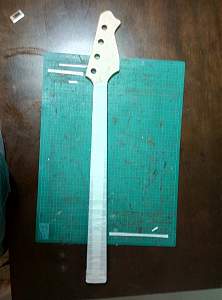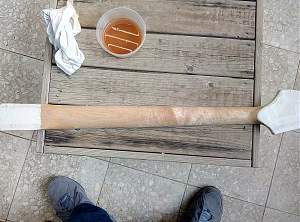The neck is maple, so won't need grain filling. The PBA-4 has an ash body, and ash is a timber that requires grain filling (it has large open pores) if you want to a achieve a flat shiny surface on the body. Not everyone does, but you won't get a flat surface all over the body without grain filling it.
You'll want to sand the body as smooth as possible first before grain filling. This smoothness will depend on the finish you want to apply. Using too fine a grit can 'over-polish' the wood so that it won't absorb stain or wax well. A maximum of P240 is best here A sprayed finish will take on a much smother surface, but there is no real point in over-smoothing the wood as you will just have to repeat the process on the finish anyway. So maybe P320 maximum for a sprayed finish. If you are spraying over staining, then stick to P240 as a maximum.
Grain filling will leave a residue on the surface of the wood that will need sanding off, so try to remove as much of the surface grain filler as possible during application. Use a plastic or rubber-edged scraper. And I'd use a light surface sanding before the grain filler sets firmly, as its far less work to remove.
Grain fill twice, as the first application is bound to have missed some areas and the grain lines in ash can have deep pits that are best filled a little at a time rather than all in one go (just like filling any large hole).
Hey all, Happy good year!
I've been sanding the neck for two hours last night with 600 and 1200 grit, the neck felt very smooth and silky until I gave it a good clean and removed all the dust... is it something familiar? should I go back to sanding?
another question, I want to apply teak oil to the neck but I want the front face of the headstock (where the logo will be) to be clear coated on top of the teak oil - will it be a problem? (I'll be using the Rust-Oleum Clear gloss spray can).
Thanks!!

I'd test the oil/decal/clear coat combination on some scrap wood first. Sometimes that's the only way to be sure that you won't have compatibility issues.
Current:
GTH-1
Completed:
AST-1FB
First Act ME276 (resurrected curb-side find)
ES-5V
Scratchie lapsteel
Custom ST-1 12 String
JBA-4
TL-1TB
Scratch Lapsteel
Meinl DIY Cajon
Cigar Box lap steel
Wishing:
Baritone
Open D/Standard Double 6 twin neck
After reading quite a lot of posts on the forum , I finally understood what I should achieve by sanding (removing all the machine/saw marks and small dents) - so I got back to sanding and after about 4 hours I was satisfied with how the neck turned out.
the next step was applying the teak oil to the neck, after testing on a scrap wood the teak oil - clear lacquer combination I decided to apply the teak oil only to the neck and not the head stock..

I applied two layers of teak oil with 6 hours cure time between each layer.
After let it cure over night (after the second layer), I attended to the head stock.
I masked the neck (where the teak oil is) and sprayed a thin coat of lacquer , after 3 hour cure time I applied my logo
Now,(finally),comes a question...
should I wet sand between the coats of lacquer? should I wet sand the first layer on top of the logo as well, or only the second/third layer? and with what grit?
Thanks
I'd get several clear coats over the decal before sanding back. Lacquer normally goes on pretty smoothly and without at least two coats on top, you'll be in danger of sanding through to the decal.
Agreed, I like seeing something a bit outside the box, tricky thing to do well.
Build 1 - Shoegazer MK1 JMA-1
Build 2 - The Relliecaster TL-1
Build 3 - The Black Cherry SG AG-1
Build 4 - The Sonicaster TL-1ish
Build 5 - The Steampunker Bass YB-4
Build 6 - The Howling Gowing ST-1
"What I lack in talent I make up for with enthusiasm"